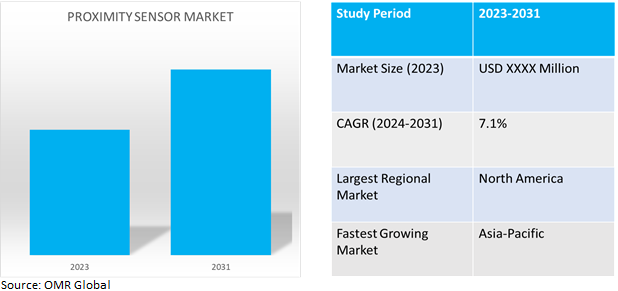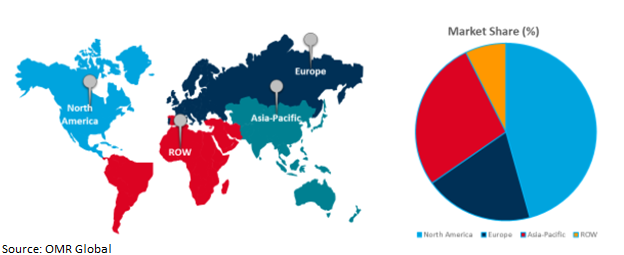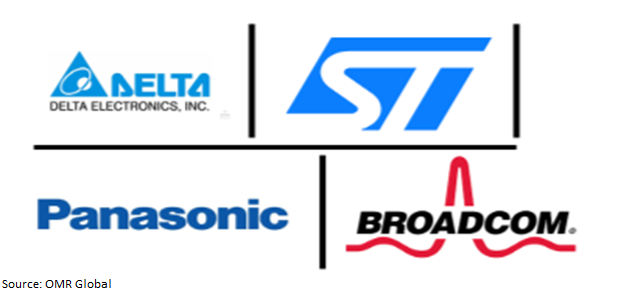Proximity Sensor Market
Proximity Sensor Market Size, Share & Trends Analysis Report by Product type (Fixed distance and Adjustable/Variable distance), by Technology (Inductive Proximity Sensor, Capacitive Proximity Sensor, Ultrasonic Proximity Sensor, Magnetic Proximity Sensor and Optical Proximity Sensor), and by Industry (Consumer electronics, Pharmaceuticals, Automobile, Industrial Manufacturing, Aerospace and Defense and Others) Forecast Period (2024-2031)
Proximity sensor market is anticipated to grow at a considerable CAGR of 7.1% during the forecast period (2024-2031). Proximity sensors have wide implications in security systems, industrial conveying systems, automation, robotics, and other industries. Its demand is growing due to technological advancement and use of sensing technology in industries such as defense, healthcare, pharmaceuticals, aerospace and other industries for threat detection, measurement, data transmission and monitoring physical movements.

Market Dynamics
Integration of IoT (Internet of Things) for Developing Infrastructure and Smart Cities
The global economy is shifting towards automation and smart cities with the integration of smart systems such as traffic management systems, fleet tracking, and wireless sensors for infrastructure management, multifunctional robots, and AR-public service information systems. Most smart systems are based on IoT, which consists of sensors, software, and other mechanical and digital machines. Governments are aiming to invest in IoT and sensor technology to manage traffic, infrastructure development, e-governance, and resource management. For instance, the Japanese government proposed society 5.0 in the 5thScience and Technology (2015-2025) basic plan for a future society. It aims to accumulate huge amounts of information from sensors in physical space into cyberspace. Further, this big data is analyzed by Artificial Intelligence (AI), and the analysis results are reverted to humans in physical space in various forms. Japan has set the goal of reaching $783 billion in R&D investment between the public and private sectors over the next five years, aiming to realize Society 5.0.
Wearable Devices and AI integration are the future of Proximity Sensors
Simultaneously, wearable technology is gaining traction globally with the launch of virtual reality (VR) and augmented reality (AR) devices by major players such as Apple, Meta, Sony, and others. These devices use a mix of contactless sensors (proximity sensors) for functioning. For instance, Apple’s vision pro uses an accelerometer, gyroscope, and IR (infrared) cameras for a mixed reality and virtual reality experience. Also, as reported by the ITIF (Information Technology and Innovation Foundation) in Europe, the AR/VR industry can reach between $38.0 billion and $70.0 billion by 2025, representing a gross added value of between $20.0 billion and $45.0 billion. Companies are looking at integrate AI into proximity sensors to enhance their utility and prospects. For instance, Elliptic Labs launched an AI Virtual Proximity Sensor that turns off the smartphone's display and disables the screen's touch functionality when users hold the device up to their ear during a phone call.
Segmental Outlook
Our in-depth analysis of the global proximity sensor market includes the following segments by technology and end-user industry.
- Based on technology, the market is sub-segmented into inductive proximity sensors, capacitive proximity sensors, ultrasonic proximity sensors, magnetic proximity sensors, and optical proximity sensors.
- Based on end-user industry, the market is sub-segmented into consumer electronics, pharmaceuticals, automobiles, industrial manufacturing, aerospace and defense, and other industries.
Inductive Proximity Sensor is the largest sub-segment
Inductive proximity sensors offer great performance and dependability, making them the ideal choice for a variety of applications. The capacity of inductive technology to identify metallic items without physical contact is the distinguishing feature that drives its popularity. This characteristic allows for widespread deployment in industries like manufacturing, automotive, and aerospace, where precise and dependable detection is critical. Inductive technology's intrinsic resistance to environmental conditions, combined with its non-contact sensing capacity, makes it a dependable solution for demanding situations, leading to its market domination.
Automobile is Expected to Drive Demand in End-User
Proximity sensors can detect objects or signals without making physical contact with the object being detected. These sensors are critical in the automobile industry because they are used to protect the car when someone tries to break into or tamper with it. Proximity sensors are widely used in automotive components such as front assist, uncommon view assist, and side assist monitoring systems. These sensors are also used for gesture control in music, navigation, HVAC, and smartphone connectivity applications. As a result, the automotive sub-segment is thriving in proximity sensors market.
Regional Outlook
The global proximity sensor market is further segmented based on geography, including North America (the US and Canada), Europe (the UK, Italy, Spain, Germany, France, and the Rest of Europe), Asia-Pacific (India, China, Japan, South Korea, and the Rest of Asia-Pacific), and the Rest of the World (the Middle East, Africa, and Latin America).
North America Holds the Highest Share of the Global Proximity Sensor Market.
North America holds the highest share of the global proximity sensor market. The key factor contributing to the growth of the market is the presence of major proximity sensor manufacturers such as Broadcom, Smith Systems, and many more, investment in smart infrastructure, growth in autonomous vehicle industry, and rising application of sensors in industrial use. For instance, in February 2024, SICK introduced a sensor that can be utilized to tackle a broader range of detection jobs in automation technology than previously possible. The sensor series consists of only four variations, each with a different working distance and mounting option. This significantly limits the typical range of types. The Class 1 laser light source, when combined with the accurate receiver evaluation line, produces precise detection results with excellent repeat accuracy. For the first time, a touchscreen interface has been integrated into a sensor of this sort, indicating that the W10's operation meets high requirements for intuitive ease of use and unique user experiences.
Global Proximity Sensor Market Growth by Region 2024-2031

Asia-Pacific is the Fastest-Growing Proximity Sensor Market
- Asia is also a growing market for consumer electronics, automobiles, pharmaceuticals, and manufacturing, thus supporting technology such as sensors are getting support from governments and demand by consuming industries.
- Ample support by the government for aiding the development of sensor and IoT technology through subsidies and ease in FDI regulations.
Market Player Outlook

*Note: Major Players Sorted in No Particular Order.
The major companies serving the global proximity sensor market include Broadcom Inc., Delta Electronics, Inc., Panasonic Corp., Smith Systems, Inc., and STMicroelectronics International N.V., among others. The market players are focusing on capitalizing on growth by adopting strategies such as collaboration, partnerships, and market expansion among others. For instance, in November 2023, DuPont collaborated with STMicroelectronics (ST) to develop a new smart wearable device concept for monitoring BioSignal.
The Report Covers
- Market value data analysis of 2023 and forecast to 2031.
- Annualized market revenues ($ million) for each market segment.
- Country-wise analysis of major geographical regions.
- Key companies operating in the global proximity sensor market. Based on the availability of data, information related to new product launches, and relevant news is also available in the report.
- Analysis of business strategies by identifying the key market segments positioned for strong growth in the future.
- Analysis of market-entry and market expansion strategies.
- Competitive strategies by identifying ‘who-stands-where’ in the market.
1. Report Summary
• Current Industry Analysis and Growth Potential Outlook
1.1. Research Methods and Tools
1.2. Market Breakdown
1.2.1. By Segments
1.2.2. By Region
2. Market Overview and Insights
2.1. Scope of the Report
2.2. Analyst Insight & Current Market Trends
2.2.1. Key Findings
2.2.2. Recommendations
2.2.3. Conclusion
3. Competitive Landscape
3.1. Key Company Analysis
3.2. Broadcom Inc.
3.2.1. Overview
3.2.2. Financial Analysis
3.2.3. SWOT Analysis
3.2.4. Recent Developments
3.3. Delta Electronics, Inc.
3.3.1. Overview
3.3.2. Financial Analysis
3.3.3. SWOT Analysis
3.3.4. Recent Developments
3.4. Panasonic Corp.
3.4.1. Overview
3.4.2. Financial Analysis
3.4.3. SWOT Analysis
3.4.4. Recent Developments
3.5. Smith Systems, Inc.
3.5.1. Overview
3.5.2. Financial Analysis
3.5.3. SWOT Analysis
3.5.4. Recent Developments
3.6. STMicroelectronics International N.V.
3.6.1. Overview
3.6.2. Financial Analysis
3.6.3. SWOT Analysis
3.6.4. Recent Developments
3.7. Key Strategy Analysis
4. Market Segmentation
4.1. Global Proximity Sensor Market by Technology
4.1.1. Inductive Proximity Sensor;
4.1.2. Capacitive Proximity Sensor
4.1.3. Ultrasonic Proximity Sensor
4.1.4. Magnetic Proximity Sensor
4.1.5. Optical Proximity Sensor
4.2. Global Proximity Sensor Market by End-User
4.2.1. Consumer electronics
4.2.2. Pharmaceuticals
4.2.3. Automotive
4.2.4. Industrial
4.2.5. Aerospace and Defense
4.2.6. Other ( Food & Beverage)
5. Regional Analysis
5.1. North America
5.1.1. United States
5.1.2. Canada
5.2. Europe
5.2.1. UK
5.2.2. Germany
5.2.3. Italy
5.2.4. Spain
5.2.5. France
5.2.6. Rest of Europe
5.3. Asia-Pacific
5.3.1. China
5.3.2. India
5.3.3. Japan
5.3.4. South Korea
5.3.5. Rest of Asia-Pacific
5.4. Rest of the World
5.4.1. Latin America
5.4.2. The Middle East and Africa
6. Company Profiles
6.1. Accent Sensor (P) Ltd.
6.2. Autonics Corp.
6.3. Electro-Sensors, Inc.
6.4. Festo Inc.
6.5. Gimatic S.R.L.
6.6. .ifm electronic gmbh
6.7. JTEKT ELECTRONICS COR.
6.8. Omron Corp.
6.9. Rockwell Automation, Inc.
6.10. SensoPartIndustriesensorik GmbH
6.11. SICK spol. s r.o.
6.12. TDK Corp.
6.13. TE Connectivity Corp
6.14. TXC Corp.
6.15. ZF Friedrichshafen AG
1. GLOBAL PROXIMITY SENSOR MARKET RESEARCH AND ANALYSIS BY TECHNOLOGY, 2023-2031 ($ MILLION)
2. GLOBAL INDUCTIVE PROXIMITY SENSOR MARKET RESEARCH AND ANALYSIS BY REGION, 2023-2031 ($ MILLION)
3. GLOBAL CAPACITIVE PROXIMITY SENSOR MARKET RESEARCH AND ANALYSIS BY REGION, 2023-2031 ($ MILLION)
4. GLOBAL ULTRASONIC PROXIMITY SENSOR MARKET RESEARCH AND ANALYSIS BY REGION, 2023-2031 ($ MILLION)
5. GLOBAL MAGNETIC PROXIMITY SENSOR MARKET RESEARCH AND ANALYSIS BY REGION, 2023-2031 ($ MILLION)
6. GLOBAL OPTICAL PROXIMITY SENSOR MARKET RESEARCH AND ANALYSIS BY REGION, 2023-2031 ($ MILLION)
7. GLOBAL PROXIMITY SENSOR MARKET RESEARCH AND ANALYSIS BYINDUSTRY, 2023-2031 ($ MILLION)
8. GLOBAL PROXIMITY SENSOR FOR CONSUMER ELECTRONICS MARKET RESEARCH AND ANALYSIS BY REGION, 2023-2031 ($ MILLION)
9. GLOBAL PROXIMITY SENSOR FOR PHARMACEUTICALS MARKET RESEARCH AND ANALYSIS BY REGION, 2023-2031 ($ MILLION)
10. GLOBAL PROXIMITY SENSOR FOR AUTOMOBILES MARKET RESEARCH AND ANALYSIS BY REGION, 2023-2031 ($ MILLION)
11. GLOBAL PROXIMITY SENSOR FOR INDUSTRIAL MARKET RESEARCH AND ANALYSIS BY REGION, 2023-2031 ($ MILLION)
12. GLOBAL PROXIMITY SENSOR FOR AEROSPACE AND DEFENSE MARKET RESEARCH AND ANALYSIS BY REGION, 2023-2031 ($ MILLION)
13. GLOBAL PROXIMITY SENSOR FOR OTHER MARKET RESEARCH AND ANALYSIS BY REGION, 2023-2031 ($ MILLION)
14. GLOBAL PROXIMITY SENSOR MARKET RESEARCH AND ANALYSIS BY REGION, 2023-2031 ($ MILLION)
15. NORTH AMERICAN PROXIMITY SENSOR MARKET RESEARCH AND ANALYSIS BY COUNTRY, 2023-2031 ($ MILLION)
16. NORTH AMERICAN PROXIMITY SENSOR MARKET RESEARCH AND ANALYSIS BY TECHNOLOGY,2023-2031 ($ MILLION)
17. NORTH AMERICAN PROXIMITY SENSOR MARKET RESEARCH AND ANALYSIS BY INDUSTRY, 2023-2031 ($ MILLION)
18. EUROPEAN PROXIMITY SENSOR MARKET RESEARCH AND ANALYSIS BY COUNTRY, 2023-2031 ($ MILLION)
19. EUROPEAN PROXIMITY SENSOR MARKET RESEARCH AND ANALYSIS BY TECHNOLOGY, 2023-2031 ($ MILLION)
20. EUROPEAN PROXIMITY SENSOR MARKET RESEARCH AND ANALYSIS BY INDUSTRY 2023-2031 ($ MILLION)
21. ASIA-PACIFIC PROXIMITY SENSOR MARKET RESEARCH AND ANALYSIS BY COUNTRY, 2023-2031 ($ MILLION)
22. ASIA-PACIFIC PROXIMITY SENSOR MARKET RESEARCH AND ANALYSIS BY TECHNOLOGY, 2023-2031 ($ MILLION)
23. ASIA-PACIFIC PROXIMITY SENSOR MARKET RESEARCH AND ANALYSIS BY INDUSTRY 2023-2031 ($ MILLION)
24. REST OF THE WORLD PROXIMITY SENSOR MARKET RESEARCH AND ANALYSIS BY REGION, 2023-2031 ($ MILLION)
25. REST OF THE WORLD PROXIMITY SENSOR MARKET RESEARCH AND ANALYSIS BY TECHNOLOGY, 2023-2031 ($ MILLION)
26. REST OF THE WORLD PROXIMITY SENSOR MARKET RESEARCH AND ANALYSIS BY INDUSTRY, 2023-2031 ($ MILLION)
1. GLOBAL PROXIMITY SENSOR MARKET SHARE BY TECHNOLOGY, 2023 VS 2031 (%)
2. GLOBAL INDUCTIVE PROXIMITY SENSOR MARKET SHARE BY REGION, 2023 VS 2031 (%)
3. GLOBAL CAPACITIVE PROXIMITY SENSOR MARKET SHARE BY REGION, 2023 VS 2031 (%)
4. GLOBAL ULTRASONIC PROXIMITY SENSOR MARKET SHARE BY REGION, 2023 VS 2031 (%)
5. GLOBAL MAGNETIC PROXIMITY SENSOR MARKET SHARE BY REGION, 2023 VS 2031 (%)
6. GLOBAL OPTICAL PROXIMITY SENSOR MARKET SHARE BY REGION, 2023 VS 2031 (%)
7. GLOBAL PROXIMITY SENSOR MARKET SHARE BY END-USER, 2023 VS 2031 (%)
8. GLOBAL PROXIMITY SENSOR FOR CONSUMER ELECTRONICS MARKET SHARE BY REGION, 2023 VS 2031 (%)
9. GLOBAL PROXIMITY SENSOR PHARMACEUTICALS MARKET SHARE BY REGION, 2023 VS 2031 (%)
10. GLOBAL PROXIMITY SENSOR FOR AUTOMOTIVE MARKET SHARE BY REGION, 2023 VS 2031 (%)
11. GLOBAL PROXIMITY SENSOR INDUSTRIAL MARKET SHARE BY REGION, 2023 VS 2031 (%)
12. GLOBAL PROXIMITY SENSOR FOR AEROSPACE AND DEFENSE MARKET SHARE BY REGION, 2023 VS 2031 (%)
13. GLOBAL PROXIMITY SENSOR FOR OTHER MARKET SHARE BY REGION, 2023 VS 2031 (%)
14. GLOBAL PROXIMITY SENSOR MARKET SHARE BY REGION, 2023 VS 2031 (%)
15. US PROXIMITY SENSOR MARKET SIZE, 2023-2031 ($ MILLION)
16. CANADA PROXIMITY SENSOR MARKET SIZE, 2023-2031 ($ MILLION)
17. UK PROXIMITY SENSOR MARKET SIZE, 2023-2031 ($ MILLION)
18. FRANCE PROXIMITY SENSOR MARKET SIZE, 2023-2031 ($ MILLION)
19. GERMANY PROXIMITY SENSOR MARKET SIZE, 2023-2031 ($ MILLION)
20. ITALY PROXIMITY SENSOR MARKET SIZE, 2023-2031 ($ MILLION)
21. SPAIN PROXIMITY SENSOR MARKET SIZE, 2023-2031 ($ MILLION)
22. REST OF EUROPE PROXIMITY SENSOR MARKET SIZE, 2023-2031 ($ MILLION)
23. INDIA PROXIMITY SENSOR MARKET SIZE, 2023-2031 ($ MILLION)
24. CHINA PROXIMITY SENSOR MARKET SIZE, 2023-2031 ($ MILLION)
25. JAPAN PROXIMITY SENSOR MARKET SIZE, 2023-2031 ($ MILLION)
26. SOUTH KOREA PROXIMITY SENSOR MARKET SIZE, 2023-2031 ($ MILLION)
27. REST OF ASIA-PACIFIC PROXIMITY SENSOR MARKET SIZE, 2023-2031 ($ MILLION)
28. LATIN AMERICA PROXIMITY SENSOR MARKET SIZE, 2023-2031 ($ MILLION)
29. THE MIDDLE EAST AND AFRICA PROXIMITY SENSOR MARKET SIZE, 2023-2031 ($ MILLION)


